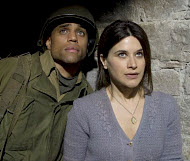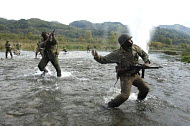Miracle at St. Anna
 for strong war violence, language and some sexual content/nudity.
for strong war violence, language and some sexual content/nudity.
Reviewed by: Jeremy Landes
CONTRIBUTOR
| Moral Rating: | Very Offensive |
| Moviemaking Quality: |
|
| Primary Audience: | Adults |
| Genre: | War Drama Adaptation |
| Length: | 2 hr. 40 min. |
| Year of Release: | 2008 |
| USA Release: |
September 26, 2008 (wide—1,100 theaters) DVD release: February 10, 2009 |










Miracles, including list of biblical miracles
MIRACLES—Has science disproved the miracles associated with Jesus Christ? Answer
Is it logical to believe that the biblical miracles really happened? Answer
“Miracles are not possible,” some claim. Is this true? Answer
What is the Biblical perspective on war? Answer
How does viewing violence in movies affect the family? Answer
What are the consequences of racial prejudice and false beliefs about the origin of races? Answer
| Featuring |
|---|
|
Derek Luke Michael Ealy John Turturro Joseph Gordon-Levitt John Leguizamo Kerry Washington James Gandolfini Walton Goggins See all » |
| Director |
|
Spike Lee |
| Producer |
| Roberto Cicutto, Jon Kilik, Spike Lee, Luigi Musini, Marco Valerio Pugini, Butch Robinson |
| Distributor |
“World War II had its heroes and its miracles.”
I’m having difficulty getting “Miracle at St. Anna” out of my head, five days after seeing it. I went in believing it was a film about black soldiers’ experiences in WWII and found something very different—a legend involving supernatural elements. Director Spike Lee’s new epic makes little attempt to reflect the reality of historical battles that African-American “buffalo soldiers” went through, and, instead, he faithfully adapts James McBride’s novel of the same name to the screen. The screenplay was written by McBride himself, and it’s hard to imagine that the author took any real pains to excise details from his book, since the film’s 166 minutes are so densely plotted with a dozen characters and hard-to-follow subplots.
“Miracle…” starts with a murder in 1983 and flashes back to 1944 in Italy. Four soldiers (a leader, a playboy, a skeptic, and a man-child) get separated from the rest of their unit after a horrific battle with Germans. They somehow enter a town surrounded by the enemy and pick up a wounded and bewildered boy on the way. In addition to these five primary characters, there’s Italian freedom fighters, a rogue German soldier, a magic statue head, and a lusty Italian woman and her family.
The film’s title sequence contains hundreds of crosses; Jesus’ name is praised by the man-child soldier, Train, when something miraculous happens; there’s a lot of hand-rubbing upon a sainted statue’s head for luck; a cross necklace worn by one of the soldiers carries special significance; and the film’s end credits scroll while a song written about God, “He’s Got the Whole World in His Hands,” is sung by a choir. So the movie is definitely “God-haunted” with these and many other references, but I wanted to learn what was really being communicated through all this iconography.
Despite the Christian themes, when a primary character in the film bears witness to the final miracle, it doesn’t seem to have much effect. He subsequently becomes bitter, haunted by the past, and bent on revenge. Lots of money plus a potent threat from a lawyer are the saving graces that finally “absolve” him and bring St. Anna to its abrupt conclusion.
Director Spike Lee has some points to communicate about the role black soldiers played in WWII and the injustices/hardships they faced to gain acceptance and respect. In the theatre where I saw the film, there was a bit of cheering while a flashback-within-a-flashback scene played, where the soldiers suffer discrimination and decide to fight back against racist civilians, brandishing their weapons. I thought the soldiers’ solution seemed a little sad and uncreative, rather than liberating.
The film’s overall look was incredible, and I was charmed by the performance of Matteo Sciabordi as Angelo, the abandoned 9-year-old who is much more than what he first seems to be. Individual scenes make St. Anna memorable, like the one-scene performance by Alexandra Maria Lara as “Axis Sally,” a German propaganda tool who taunts the black soldiers, from her sanctuary radio studio, declaring that they are being exploited by their white commanders and letting themselves become the latest victims of America’s historic suppression of non-whites.
If you choose to see “Miracle at St. Anna,” be on your guard. Horrific war violence against helpless victims, its overall promotion of revenge, unnecessary scenes with nudity, and its advocacy of sex as being a mere pleasure tool keep me from recommending it easily to another follower of Jesus. I regret letting many of its images into my head. I’m guessing that there’s a compelling forty minutes of story within this sprawling mess of a movie. Based on this information you now have, ask yourself whether it’s really worth hunting for these good scenes.
If you would like to watch a story about black soldiers in Italy during WWII, try checking out “Paisan” instead from your library or an online video service. Ken Burns’ documentary, “The War,” is an excellent source of truth, too.
Violence: Heavy / Profanity: Heavy / Sex/Nudity: Heavy
See list of Relevant Issues—questions-and-answers.


none
The story seems intriguing, but is lost in a muddled, confused and boring presentation. I never felt for any of the characters—and the problem of racial discrimination is touched in a way that makes you not really care. (I hate to say this, because I am in no way racist. All men are created equal, as God's children. But this film is just terrible.) I can't even talk about this anymore. I think I'll fall asleep. DO NOT see this movie!!!
Moral rating: Offensive / Moviemaking quality: 1½


My Ratings: Moral rating: Excellent! / Moviemaking quality: 5